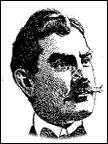George W. Maher
 George Washington Maher (1864-1926) apprenticed as a draftsman in the Chicago architectural office of Augustus Bauer and Henry Hill. Later, he worked for acclaimed residential architect Joseph Lyman Silsbee, where he became associated with such co-workers as George Grant Elmslie (designer of two Peoples Gas neighborhood stores) and Frank Lloyd Wright. In 1893, Maher opened his own practice. A longtime resident of the suburb of Kenilworth, Maher maintained a broad list of social contacts and club memberships, which resulted in numerous residential commissions from important figures on the North Shore and in Oak Park.
George Washington Maher (1864-1926) apprenticed as a draftsman in the Chicago architectural office of Augustus Bauer and Henry Hill. Later, he worked for acclaimed residential architect Joseph Lyman Silsbee, where he became associated with such co-workers as George Grant Elmslie (designer of two Peoples Gas neighborhood stores) and Frank Lloyd Wright. In 1893, Maher opened his own practice. A longtime resident of the suburb of Kenilworth, Maher maintained a broad list of social contacts and club memberships, which resulted in numerous residential commissions from important figures on the North Shore and in Oak Park.
Maher is considered one of the important Prairie School-style architects who practiced during the late-19th and early-20th centuries. He blended traditional American house styles with more progressive European Arts & Crafts-style designs. Many of his residences reflect a broad horizontal character, with overhanging roof eaves, a strong rectilinear massing, and symmetrically placed windows centered on a prominent central entry. One of the largest concentrations of Maher's work is along Hutchinson Street, on Chicago's North Side lakefront.
Maher also was known for his "motif-rhythm" theory of design, which used the form of an indigenous plant as the unifying motif for an individual project. "The leading flower of a neighborhood is nature's symbol of the spirit breathed there," Maher said. The Patten House in Evanston (1902; demolished) and the King-Nash House, for example, both used a thistle; the Rubens House in Glencoe adopted a hollyhock; and the Magerstadt House in the south side Kenwood District used a poppy.